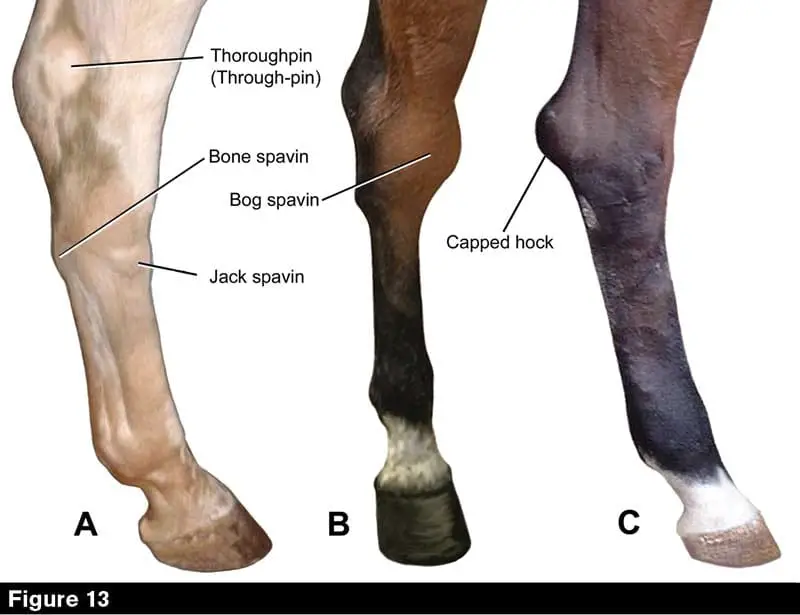Last Updated on August 21, 2023 by Allison Price
Before your vet arrives, here are some ways to reduce swelling at the horse’s hock point.
What you see with a Capped Hock
The swelling is a soft, fluid-filled lump that extends from your horse’s point of the hock. The swelling is not painful and your horse won’t be irritated if you touch it with your fingers.
What should you do?
1. Within 24 hours, call your veterinarian to schedule an appointment.
What’s the problem? Although this is not an emergency that requires immediate attention, you should not delay treatment for more then a day. A capped hock is usually caused by direct trauma to the hock. Trauma is most often caused by your horse striking something, such as a trailer wall or stall wall, banging his hock point.
The cause of swelling is the enlargement and protection of the Bursa. This fluid-filled sac surrounds the bone’s point to prevent it from trauma. Rapid veterinary treatment can reduce swelling and even eliminate it. If a capped hoof is left untreated, it’s more likely that inflamed tissues will continue to thicken, leading to a permanent blemish.
2. Alternate between hot and cold treatments
Why? To reduce inflammation, stimulate circulation, as well as to limit swelling.
How:
- In a 2-gallon bucket, combine 1/2 gallon of well-crushed ice, frozen peas, 1 gallon resealable freeze bag, Epsom salts, small towel and 1 gallon warmwater (the water temperature should be the same as a hot bath).
- Place the frozen peas or crushed ice in a freezer bag. Seal the bag and leave it alone.
- Combine 1/2 cup Epsom salts with a bucket of warm water. You can tie your horse to a stable post or ask someone to help you. The salt solution will soak the terrycloth towel. After wringing it, fold it in half and then place it on your horse’s capped hoof for 2 minutes. The towel can be returned to the warm water.
- For 5 minutes, place the cold pack on top of your horse’s capped hoof.
- This session, repeat the hot/cold cycle 3 times more.
- You should repeat the four-cycle sessions three times a day until you see your veterinarian.
3. Make a soothing poultice and apply it.
Why? To encourage the reabsorption of any fluid (fluid trapped in the skin and deeper tissue) and to prevent any further inflammation.
Make the poultice by mixing 1/2 cup Epsom salts and enough water to form a paste. Raw oatmeal, the “quick” variety, can be used in place of Epsom salts. You can also find commercial poultices; make sure to read the labels and stay away from those that generate heat or blistering.
Spread 1/2 to 1 cup poultice on the horse’s point. Then, place the poultice down onto the joint. Cover the poultice loosely with plastic cling wrap. Cover the plastic wrap with a track or polo bandage. The hook-and-loop fastener will be safer than the string-tie. Wrap the bandage or wrap in a figure-8 configuration so that the hock’s plastic covered point is exposed. Allow him to remain in his stall for approximately one hour. Once he is comfortable, remove any wraps and return to the clinic.
Prognosis
It is important to keep your horse safe. The vet will likely cut and disinfect the affected skin, tap it. This is where the veterinarian inserts a needle into the horse’s bursa to withdraw fluid and then injects a small amount anti-inflammatory medication. To help dry out the tissues, he or she might also inject an astringent medication.
Your vet may also recommend preventive measures depending on the severity of the injury. You may be able to install kick boards in your horse’s stall, change his stabling arrangements so that he isn’t next to horses that upset him, change his bedding if it’s difficult for him to rise without falling; or apply tall shipping wraps if the horse is kicking in the trailer. Please Note: Some horses kick more if their hind legs are wrapped. If this is the case, consult a professional trainer.
For the next two weeks, exercise your horse with care. To keep his circulation going without irritating his already painful bursa, limit his exercise to just 1/2 hour per day. Your vet may recommend that you continue with the hot/cold or poultice treatments for those two weeks. You will generally see what you get at the end of the 2 weeks. It is worth it to be thorough with your treatment.



